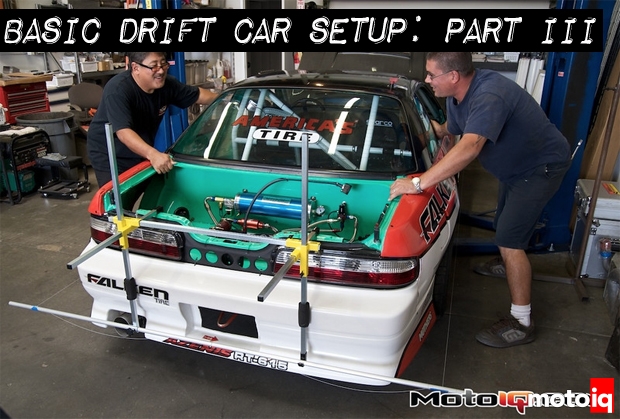,
 |
| You cannot easily adjust the alignment of a rear solid beam axle car like an AE86. A good chassis shop can bend the beam so you can get a little negative camber and toe in if you desire that. |
Rear Wheels
A beam axle car like an AE86 isn’t adjustable so you can’t go much further with one of those but rear alignment is critical in getting a drift car to handle well and drift easily.
 |
| Vaughn Gittin Jr's Mustang has a very sophisticated beam axle modified with CV joints in the hubs so his rear alignment is totally adjustable. It's really cool and really expensive! |
Camber
On a drift car you want to run the rear camber as close to zero as possible. This will usually give you the best tire wear, and best forward bite. If you want a little more side grip you can run some negative camber but usually no more than one degree negative should be run.
 |
| Toe is being adjusted and measured at the same time to speed things up. |
Toe
This is a subject that has a lot of misconceptions as many people try to tune how the car is balanced in drift by adjusting the rear toe. You should not run too much rear toe in on a drift car. In doing this you will have a car that will straighten up if the throttle is lifted or modulated. This is the leading cause of serious drift car crashes. A car's understeer oversteer balance should always be adjusted in the suspension, not by using the toe. If you want the car looser with more oversteer, increase the rear bar stiffness and or rear spring rate and stiffen the rear shock. If you want to tighten up the car with less oversteer, run softer rear bar, spring and shock.
 |
| Using a lot of toe in to “add more rear grip” is a bad idea and a common mistake made by many drift suspension experts. It is not adding more rear grip, just rear steer and makes the car a lot more twitchy and hard to drive. The car will spin easier and tend to straighten out and shoot straight into walls and stuff with too much toe. To get more rear grip, you must play with the springs, bars, shocks and tire pressure. A little rear toe in helps the car's slide stability. |
You want to run a little toe in. Usually you want to run about 1/8” toe in with most cars. Cars with semi trailing arm rear suspensions like BMW E30’s, Nissan Z31’s and S12’s can run a little more like ¼” toe in as these cars will toe out under roll. If you are having trouble making angle in high speed turns you can run zero rear toe but never run rear toe out, that will make your car very twitchy. If your car is too loose and you don’t have suspension adjustment you can add more rear toe to help stabilize the car but it is not a good idea to exceed ¼” toe in.
Nissan S chassis traction rod
On a Nissan S chassis, shortening the traction rod increases toe in under roll and gives you more forward bite. Lengthening it has the opposite effect.
 |
| The Nissan S Chassis traction rod is the forward most upper link. Making it shorter adds more rear toe under roll. Making it longer reduces rear toe under roll. This is better than adding static rear toe. Usually it is best to leave the traction rod about the same length as stock. |
These are the basics of drift car chassis set up, do this right and you will be ahead of the game and ahead of most other people. When you move up to Pro Am, are starting to do some serious tandem drifting or are getting into the pro levels, there are many other tricks can be apply but these require quite a bit more technical background to apply. We will cover these later.
Remember have fun, don’t be afraid to experiment to find what is best for you and don’t practice on the street!
For more on drift chassis setup read “The Ultimate Guide to Suspension and Handling”




2 comments
When talking about toe in toe out are you talking per side or both sides total?
Both Sides total